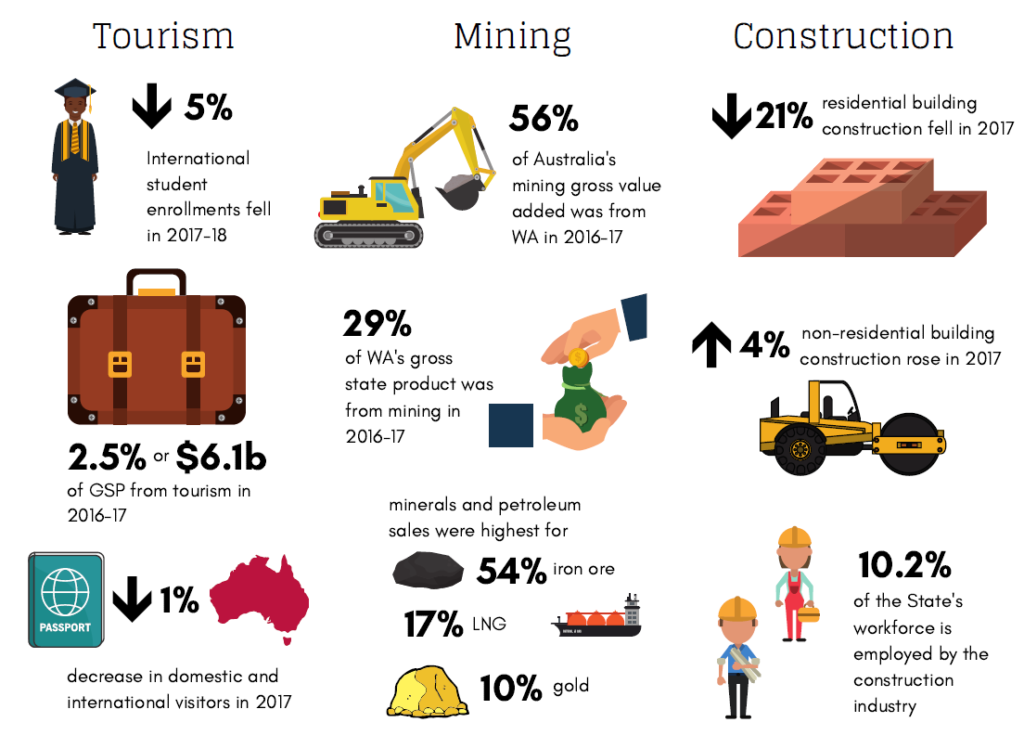The latest FACTSheet produced by the Committee for Perth contains a snapshot of key facts and figures relating to the current performance of Perth and Western Australia. It draws on data from a range of sources including FACTBase reports, Committee for Perth research, government departments and media sources.
Population growth
- Western Australia’s population of 2.58 million in 2017 was 10% of Australia’s population.
Population growth of 0.8% or 21,395, in 2017 was below annual average growth of 1.9% over the past 10 years. - Natural increase of 20,004, and net overseas migration increase of 14,209, offset falling net interstate migration which was down 12,818 in 2017.
- Annual average population growth is forecast to rise to 1.0% in 2017-18 and 1.2% in 2018-19.
The 2015 WA Tomorrow report forecasts a population of 3.27 million by 2026.
Labour market
Employment (monthly)
- Western Australia’s total employment rose by 4,229 to 1.35 million in August 2018, with an increase in both full-time employment – up 828 to 914,507, and part-time employment up 3,401 to 430,530.
- Total employment rose 2% or 20,000 through the year to August 2018, with an increase in both full-time employment – up 1% or 9,519, and part-time employment up 2% or 10,481.
- The 2018-19 Western Australian Government Budget forecasts annual average employment growth of 1.5% in 2018-19 and 2% in 2019-20.
Industry sector employment (quarterly)
- Services industries accounted for 72% or 965,602 of total employment in the September quarter 2018 and goods-producing industries accounted for 28% or 370,055.
- The largest increases in employment through the year to the September quarter 2018 were in public administration and safety up 22,190, and mining up 20,471.
- The largest falls in employment through the year to the September quarter 2018 were in construction, down 19,915, and education and training, down 10,321.
- There were 27,600 job vacancies in the September quarter 2018, 3,500 more than in the previous quarter and 8,300 more than a year ago.
Unemployment rate (monthly)
Western Australia’s unemployment rate remains the worst in the country, despite a slight fall in the jobless rate in December on a seasonally adjusted basis. The unemployment rate fell slightly in December, according to Australian Bureau of Statistics figures released in January, dropping 0.2% to 6.3%. That compares with a national jobless rate of 5%, down slightly from November. But while the figures suggest WA is still lagging the rest of the country, WA’s participation rate – the portion of people looking for work – remains at far higher levels than in other states, at 68%. The national participation rate is 65.6%.
The 2018-19 Western Australian Government Budget forecasts an annual average unemployment rate of 5.75% in 2018-19 and 5.5% in 2019-20.
Investment
Western Australia accounted for 19% of Australia’s business investment in 2017-18. Business investment accounted for 15% of GSP in 2016-17 but detracted 6.4% from real GSP growth. Real business investment rose 0.1% in 2017-18 and is forecast to fall 14% in 2018-19 and rise 6% in 2019-20. Nominal business investment rose 1% to $38.2 billion in 2017‑18. Nominal public investment rose 3% to $9.2 billion in 2017‑18.
Service exports
Services exports in 2017 mainly comprised personal travel (34%) and education-related travel (28%). International student enrolments fell 5% to 52,337 in 2017-18, compared with annual average growth of 3% over the past 10 years. Western Australia accounted for 6.1% of Australia’s international student enrolments in 2017-18, below the 7.1% share in 2016-17.
Tourism
Tourism accounted for 2.5% or $6.1 billion of GSP and 5% or 71,100 of total employment in 2016-17. In 2017, domestic visitors was down 1% to
9.6 million, and international visitors down 1% to 946,100.
Visitor spending fell 5% to $9.6 billion in 2017 due to decreases in spending by domestic visitors, down 7% to $5.3b and international visitors down 6% to $2.2b.






Comments are closed.